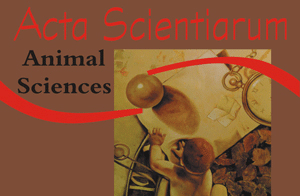Resumo em Português:
Objetivou-se avaliar a composição bromatológica da silagem de híbridos de milho em cultivo de segunda safra no Estado do Mato Grosso. Utilizou-se o delineamento experimental em blocos casualizados com 23 tratamentos (híbridos) e três repetições. A forragem foi acondicionada em tubos de PVC sob densidade de 600 kg de massa fresco m-3. A abertura dos silos ocorreu 90 dias após a ensilagem, sendo avaliados: valor de pH, teores de matéria seca (MS), nitrogênio amoniacal (N-NH3), proteína bruta (PB), fibra em detergente ácido (FDA), fibra em detergente neutro (FDN), nutrientes digestíveis totais (NDT) e minerais (Ca, P, K e Mg).Também foram estimados os valores do consumo de matéria seca (CMS), digestibilidade "in vitro" da matéria seca (DIVMS), energias líquidas de mantença (ELm), ganho (ELg) e de lactação (ELl). Todas as características avaliadas foram determinadas por meio de espectrofotometria de infravermelho proximal (NIRS). Com relação ao padrão fermentativo, as silagens dos diferentes híbridos tiveram valores adequados de pH e NNH3. As silagens dos híbridos DKB 370, DKB 330, DAS 2C520, DAS 2B710, DAS 2B587, BF 9534, AG 9010, AG 8088, AG 5020, BE 9701, AGN 30A06 e AGN 31A31 apresentaram menor teor de FDN e maior valor estimado de CMS.
Resumo em Inglês:
Nutrition value of silage from corn hybrids produced in Mato Grosso, State was evaluated. A randomized block design was used with 23 treatments (hybrids) and three replications. The study used hybrids from different seed companies. Fodder was stored in PVC pipes at a density of 600 kg of green mass m-3. The silos were opened 90 days after ensiling, and the following variables were studied: pH, dry matter (DM), ammoniacal nitrogen (N-NH3), crude protein (CP), acid detergent fiber (ADF), neutral detergent fiber (NDF), total digestible nutrients (TDN) and minerals (Ca, P, K and Mg). Rates were estimated for dry matter intake (DMI), dry matter digestibility (DM), net energy for maintenance (NEm), gain (NEg) and lactation (EL). All the characteristics were determined by near-infrared spectroscopy (NIR). With regard to standard fermentation, silage of different hybrids had appropriate values for pH and N-NH3. The silage of hybrids DKB 370, DKB 330, DAS 2C520, DAS 2B710, DAS 2B587, BF 9534, AG 9010, AG 8088, AG 5020, BE 9701, AGN 30A06 e AGN 31A31 showed lower NDF and higher estimated DMI values.
